Mostrar el registro sencillo del ítem
dc.contributor.author
Exner, Eliana de Luján

dc.contributor.author
Zabala, Juan Marcelo

dc.contributor.author
Pensiero, Jose Francisco

dc.date.available
2020-02-23T22:57:50Z
dc.date.issued
2010-08
dc.identifier.citation
Exner, Eliana de Luján; Zabala, Juan Marcelo; Pensiero, Jose Francisco; Variations in flowering phenology and reproductive success in Setaria lachnea; Colegio de Postgraduados; Agrociencia; 44; 7; 8-2010; 779-789
dc.identifier.issn
1405-3195
dc.identifier.uri
http://hdl.handle.net/11336/98390
dc.description.abstract
Setaria lachnea, moha perenne, is a native grass with excellent forage quality; thus, its introduction to cultivation has been recommended. Therefore, in the present study, the variability in flowering phenology and reproductive success of three Argentine populations from different places by altitudinal gradient have been analyzed, with respect to points of interest for selecting materials. A completely randomized experimental design was used, with 10 genotypes per population and 3 replications per genotype. Flowering phenology was analyzed through variables of flowering start and mid-flowering; the number of panicles was quantified by observation, the number of the total of panicles and reproductive success by fruiting percentage. For flowering start only significant (p£0.05) intrapopulation variations were found. Seventy-five percent of the genotypes started flowering in November 2005. For mid-flowering, there were significant inter- and intra-population differences (p£0.05). The intrapopulation variability observed will allow selecting genotypes with prolonged vegetative period. Reproduction success, measured as mean fruiting percentage, was 41 (high for a nondomesticated species), with variation from 3 % to 80 %. In the two analyzed years (2005-2006), significant inter- and intra-population differences (p£0.05) were found. Genotypes of the population of less height stood out by their high fruiting percentage, always above 40 %; however, there was no variation pattern associated to altitude. Beginning of flowering was not correlated with fruiting percentage; therefore, it will be possible to select late-ripening materials, without altering fruiting percentage. , moha perenne, is a native grass with excellent forage quality; thus, its introduction to cultivation has been recommended. Therefore, in the present study, the variability in flowering phenology and reproductive success of three Argentine populations from different places by altitudinal gradient have been analyzed, with respect to points of interest for selecting materials. A completely randomized experimental design was used, with 10 genotypes per population and 3 replications per genotype. Flowering phenology was analyzed through variables of flowering start and mid-flowering; the number of panicles was quantified by observation, the number of the total of panicles and reproductive success by fruiting percentage. For flowering start only significant (p£0.05) intrapopulation variations were found. Seventy-five percent of the genotypes started flowering in November 2005. For mid-flowering, there were significant inter- and intra-population differences (p£0.05). The intrapopulation variability observed will allow selecting genotypes with prolonged vegetative period. Reproduction success, measured as mean fruiting percentage, was 41 (high for a nondomesticated species), with variation from 3 % to 80 %. In the two analyzed years (2005-2006), significant inter- and intra-population differences (p£0.05) were found. Genotypes of the population of less height stood out by their high fruiting percentage, always above 40 %; however, there was no variation pattern associated to altitude. Beginning of flowering was not correlated with fruiting percentage; therefore, it will be possible to select late-ripening materials, without altering fruiting percentage.
dc.format
application/pdf
dc.language.iso
eng
dc.publisher
Colegio de Postgraduados

dc.rights
info:eu-repo/semantics/openAccess
dc.rights.uri
https://creativecommons.org/licenses/by-nc-sa/2.5/ar/
dc.subject
NATIVE FORAGE
dc.subject
ALTITUDINAL GRADIENT
dc.subject
SETARIA
dc.subject
INTERPOPULATION VARIABILITY
dc.subject.classification
Agronomía, reproducción y protección de plantas

dc.subject.classification
Agricultura, Silvicultura y Pesca

dc.subject.classification
CIENCIAS AGRÍCOLAS

dc.title
Variations in flowering phenology and reproductive success in Setaria lachnea
dc.type
info:eu-repo/semantics/article
dc.type
info:ar-repo/semantics/artículo
dc.type
info:eu-repo/semantics/publishedVersion
dc.date.updated
2020-02-13T18:59:17Z
dc.journal.volume
44
dc.journal.number
7
dc.journal.pagination
779-789
dc.journal.pais
México

dc.description.fil
Fil: Exner, Eliana de Luján. Universidad Nacional del Litoral; Argentina
dc.description.fil
Fil: Zabala, Juan Marcelo. Universidad Nacional del Litoral; Argentina
dc.description.fil
Fil: Pensiero, Jose Francisco. Universidad Nacional del Litoral; Argentina
dc.journal.title
Agrociencia

dc.relation.alternativeid
info:eu-repo/semantics/altIdentifier/url/https://www.colpos.mx/agrocien/Bimestral/2010/oct-nov/art-5.pdf
Archivos asociados
